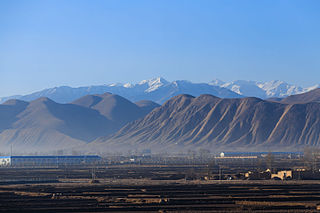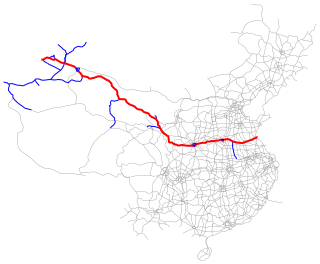
Tongling is a prefecture-level city in southern Anhui province. A river port along the Yangtze River, Tongling borders Wuhu to the east, Chizhou to the southwest and Anqing to the west.

Guanyin District is a rural, coastal district in western Taoyuan City, Taiwan. Guanyin is the name of a Buddhist goddess.

The Lanzhou−Xinjiang railway or Lanxin railway is the longest railway in northwestern China. It runs 1,904 kilometers (1,183 mi) from Lanzhou, Gansu, through the Hexi Corridor, to Ürümqi, in the Xinjiang. It was Xinjiang's only rail link with the rest of China until the opening of the Lanzhou–Xinjiang high-speed railway in December 2014. The railway follows the path of the ancient Silk Road.

Bairi (Tianzhu) Tibetan Autonomous County is in the prefecture-level city of Wuwei in the central part of Gansu province, China, bordering Qinghai province to the south and west. It has an area of 7,147 km2 (2,759 sq mi) and approximately 230,000 inhabitants (2003). Its administrative seat is the town of Huazangsi.

Wuwei is a prefecture-level city in northwest central Gansu province. In the north it borders Inner Mongolia, in the southwest, Qinghai. It is centrally located in between three western capital cities, Lanzhou, Xining, and Yinchuan, making it an important business and transportation hub for the region. Because it is positioned along the Hexi Corridor, historically the only route from central China to western China and the rest of Central Asia, many major railroads and national highways pass through Wuwei, nowadays.
The Wushaoling Tunnel is a 21.05 km dual-bore railway tunnel in Gansu, north-west China. The east-bound bore opened on 30 March 2006. The west-bound bore is expected to open in October 2006. It was briefly the longest railway tunnel in China until the opening of the 27.84 km Taihang Tunnel in late 2007.
Li Gui, courtesy name Chuze (處則), was the emperor of a short-lived state of Liang, which he established at the end of the Chinese Sui Dynasty. He governed the parts of modern Gansu west of the Yellow River. In 618, he briefly considered submitting to Emperor Gaozu of Tang, with whom they both believed he had a distant family relationship, but ultimately rejected the idea. In 619, the Tang Dynasty official An Xinggui (安興貴) pretended to submit to him, and then started an uprising at his capital Wuwei, overthrowing him and turning him over to Emperor Gaozu, who executed him.

Zhongwei is a prefecture-level city of Ningxia, People's Republic of China.

Gulang County is a county in central Gansu province, the People's Republic of China, bordering Inner Mongolia to the northeast. It is under the administration of Wuwei City. Its postal code is 733100, and its population in 2006 was 393,200 people. Located in the east of the Hexi Corridor and to the south of the Tengger Desert, it borders Jingtai County to the east, Tianzhu County to the south, Liangzhou District to the northwest, and Inner Mongolia's Alxa Left Banner to the northeast.

Minqin County is a county of Gansu province, the People's Republic of China. It is under the jurisdiction of Wuwei City. Its postal code is 733300, and its population in 1999 was 281,826 people.

Liangzhou District is an district and the seat of the city of Wuwei, Gansu province of the People's Republic of China, bordering Inner Mongolia to the east.
Zhang Ji was a military general serving under the warlord Dong Zhuo during the late Eastern Han dynasty of China.

The Wuwei Corps or Guards Army was a modernised army unit of the Qing dynasty. Made up of infantry, cavalry and artillery, it was formed in May or June 1899 and trained by western military advisers. The guard took responsibility for the security of Peking (Beijing) and the Forbidden City, with Ronglu as its supreme commander. This move was an attempt by the Qing imperial court to create a western-style army equipped with modern weaponry following the Qing Empire's defeat in the First Sino-Japanese War. Three out of the five divisions of the Wuwei Corps were disbanded after two years due to attrition caused by the Boxer Rebellion.

The Lianyungang–Khorgas Expressway, commonly referred to as the Lianhuo Expressway, is 4,243-kilometre-long expressway (2,636 mi) in the People's Republic of China that connects the cities of Lianyungang, in the province of Jiangsu, and Khorgas, in the autonomous region of Xinjiang, on the border with Kazakhstan. At Khorgas, there is a border crossing into Kazakhstan. The expressway is the longest contiguous expressway in China with a single numeric designation, stretching across the country from the Yellow Sea on the east coast to the Kazakhstan border in the west. It passes through the provinces of Jiangsu, Anhui, Henan, Shaanxi, Gansu, and Xinjiang.

The Dingbian–Wuwei Expressway, commonly referred to as the Dingwu Expressway is an expressway that connects Dingbian County, Yulin, Shaanxi, People's Republic of China and Wuwei, Gansu. It is a spur of G20 Qingdao–Yinchuan Expressway.

Wuwei Road is a station on Line 11 of the Shanghai Metro. It opened on December 31, 2009.
Luodao or Luoism (罗教), originally Wuweiism (无为教), refers to a Chinese folk religious tradition, a wide range of sect organisations flourishing over the last five hundred years, which trace their origins back to the mystic and preacher Luo Menghong (1443-1527), the Patriarch Luo and the revelation contained in his major scripture, the Wǔbùliùcè, which official title is The Scroll of Apprehending the Way through Hard Work and that marked the beginning of the precious scrolls' tradition.

















